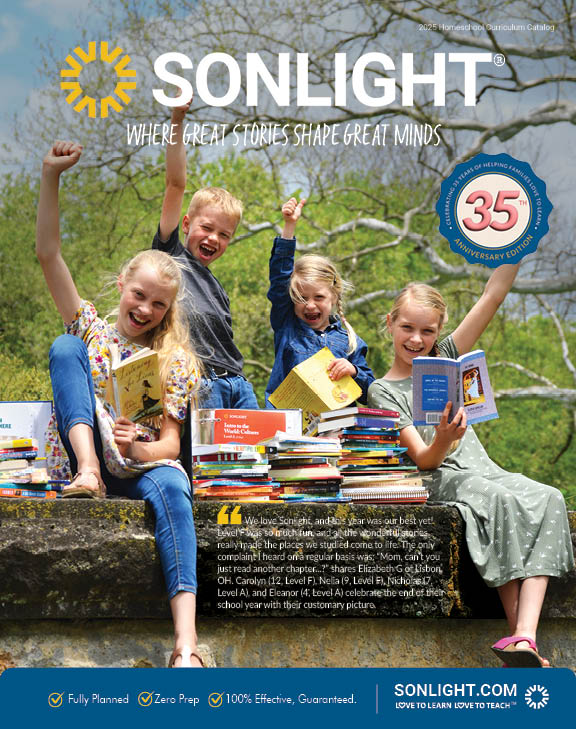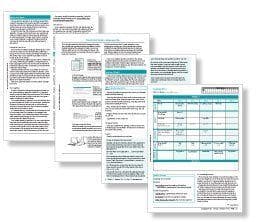Sonlight Books: An Uncommon Collection
By Sarita Holzmann
I have reviewed tens of thousands of children's and young-adults' books over the last 25 years. That background helps me evaluate every book I read. And it helps me find the outstanding books – the only ones that make it into a Sonlight program.

Every book in the Sonlight programs has to pass. . .
Sarita's seven-part test
- Real/realistic characters. Heroes should not be flawless. Anti-heroes ought not to be thoroughly detestable. They need to be nuanced and complex – the way real people are.
- Solid character development. The protagonist must change for the better over the course of the book.
- Content that adds to the reader's cultural literacy. The book's plot, setting, characters, or vocabulary – something – must contribute to a reader's knowledge about world events and cultures, or their understanding of "the way things work" in human relations, in life.
- Intriguing, multi-dimensional plot.
- Emotionally compelling. The story has to move me.
- Verbally beautiful. The writing must be superb and allow for fluent reading – silently or aloud.
- Re-readable. I have to like it enough to want to read it over and over again.
After I find outstanding books, I prepare to combine them into a program.
At this point, I don't just look for my favorites (though I usually manage to include most of them). I have …
Further requirements
I want diversity. I don't want all the authors, nor all the characters, to be from the United States or Western Europe. The world is too varied for that!
Ideally, I don't want to include many books by the same author. There are a few authors who merit more than one book, particularly if they fill a needed niche. (Early readers with compelling plots? Clyde Robert Bulla. Superb early chapter books? Andrew Clements. Widely varied historical horse books? Marguerite Henry. And creative, marvelous books for readers of all ages? E.L. Konigsburg.)
But the few outlier authors aside, my hope is that Sonlighters will find authors they enjoy, and then seek out sequels or other books by the same authors.
I receive publishers' catalogs throughout the year. Part of my vision is to ensure that quality books continue to be published. This isn't guaranteed. I count it a privilege to be able to supply top-notch books, and to support, through royalties, so many first-rate authors.
Besides diversity in characters and authors, when I design a program, I seek to include a wide variety of literary genres, a mix of easier books and more-challenging books, and books that will appeal to both boys and girls.
Let's look at each of these in turn.
A wide variety of literary genres
I want to introduce your children to things they wouldn't discover on their own.
If you are considering whether to read a single book, you're likely to skip it entirely if it is a genre that you don't usually prefer. But if it's part of a complete program, although you might not be excited at the thought of reading science fiction (or romance, or biography), you will likely try it. After all, it's in the schedule, and it takes less thought to read it than to find a substitute.
Every year, I hear from customers who say, "I've never read a fantasy [or poetry, or science fiction, or …] book before! I'm astonished at how lovely it is!"
By using one of Sonlight's programs, you and your children are likely to read more widely than if you choose all the books individually on your own – because I've made those tough choices for you.
A mix of easier and harder books
Especially for students just beginning to read, I think it's important not to always make them work at the furthest extent of their ability.
Perhaps you've played sports. A runner doesn't usually sprint during the entire practice. That wouldn't be the most effective way to train. No. The coach usually gives some warm-ups. Then maybe some distance work, some strength training, and so on. At some point, the runner races, and perhaps sprints, but typically that race isn't long.
If parent-teachers make their children continually work at the furthest extent of their abilities, that is like making the children sprint. All the time.
How exhausting!
When I design a set of Readers, I include a mix of books that will require more effort, and easier books that will remind the children of their successes, and entice them to keep going.
Similarly with all of the Read-Aloud programs. Some books are more challenging, and some books are more fun. ("Fun" does not mean "twaddle." Even the fun books are high-quality.)
This is why you'll find books that feature a range of reading difficulties in every package.
I'm convinced, based on comments from customers through the years, that if you purchase a Sonlight program, you're more likely to finish, to help your children persevere through the hard parts, because you'll recognize that each book is part of a balanced whole, and that the package, as a whole, was designed to provide a variety of experiences.
Books for both boys and girls
This is a more complex statement than it might first appear. In part, it means that I choose books by both male and female authors, and that each program has books with boy characters and books with girl characters, in approximately equal numbers.
It also means that I pay attention to plot lines. I want books that will appeal to both boys and girls. And I don't just mean that I'm looking for "boy" books (like adventure) and "girl" books (like romance).
More, I'm looking for books that – whatever the genre, whomever the protagonist, and whatever the topic – both girls and boys will love … simply because these are books they can't put down.
This work of choosing fine books, as you might expect, requires a lot of time. But at some point, I successfully gather a promising collection of titles.
And then it's time to schedule them into a Sonlight program.
Choices related to the schedule
As I develop the curriculum itself, I ask more questions.
What is the time period and geographical setting of this book? For example, in American History, it wouldn't be ideal to have all the books set above the Mason-Dixon line (too similar geographically), or all clustered around the Revolutionary War (too similar chronologically).
What tie-ins are there between this book and others in this program? When George Washington turns up in a Reader after you've read about him in History, the thrill of recognition is far beyond what you would expect. Truly, it's like meeting an old friend.
How long and difficult is this book to read, and how much time should we allot it within our overall course of study? When I revised the Sonlight 100 program some years ago, I dropped one of my favorite books, Catherine Marshall's marvelous retelling of her mother's young adulthood in the Smoky Mountains. I did so because I realized that, in the same amount of time, students could read excellent books on World War I, World War II, and the Civil Rights movement. I realized that it was far better to offer three excellent books about three important subjects and periods of time than to have studedents read just one book about one place and time – delectable as that book may be. (And in case you're wondering, yes, I would still recommend Christy, if you want a great read!)
Where are the natural breaks within the text that will match the demands of our overall schedule? If possible, I prefer to break off the reading at the more exciting moments. I want your children to be eager for more!
At this point, I create the outline for an Instructor's Guide (IG) – the basic schedule and assignments.
And then my development team takes over to create the full IG.
Two values integrated into Sonlight's curriculum
Sarita Holzmann, founder and president of Sonlight, strongly believes in the benefit of reading and helping students see how they can make a difference in the world. These two values permeate every Sonlight program. Sarita says…
› Reading
I think back to when I was growing up and going to school. What inspired me? What taught me? Where did I learn?
It was not entirely in the classroom!
My fifth grade teacher was very strict and unapproachable . . . except for one thing. Every day, she set aside time to read to us from wonderful books, like The Horse and His Boy, Follow My Leader, and Beautiful Joe. I loved that time. It brought me to other places and moved my soul. The books made me think and feel in new ways. That time every day actually redeemed that year at school for me.
I did not learn just in the classroom. I learned by reading.
Because I loved reading so much, every week I would ride my bike to the library and check out the 50 book limit. I would load them into my saddle bags, ride home, read them all during the week, then bring them back the following week and refill my saddle bags and my heart once more.
And when I think about all those books, I realize – I learned a lot.
No one was cramming anything down my throat. I wasn't being forced to memorize pieces of information that I would then have to regurgitate on a test. I knew the information because I had lived the stories. I had seen them, felt them, experienced them. I had been there.
- When my classmates were studying the Revolutionary War, I was already ahead of them because I had read Celia Garth.
- I had confidence I could take care of a rattlesnake bite (if that ever came my way) because I had read Trixie Belden and had actually experienced dealing with such an emergency because Trixie's younger brother had been dying from such a wound before Trixie helped him.
- I knew about longitude, not because I had made a formal study of the subject, but because I had been there, experiencing what longitude was all about right there beside Nathaniel Bowditch in Carry On, Mr. Bowditch.
I think about my kind of learning and put it up against what my classroom teachers often did: make us memorize "facts," spelling and vocabulary lists, grammar rules, and so forth.
There's simply no contest. Give me the books any day. I will read them. I will learn (painlessly). I will remember what I have learned. I will be able to tell and teach others.
Education – real education – is so much more, so different from memorizing and organizing data! I want children to know not only facts, but the reasons for things, the stories behind the facts, how the facts fit together.
I want them to gain discernment and wisdom. I want them to acquire the ability to place current events – their lives – in the context of today and of world history. I think learning by reading uniquely fosters this, in a way that memorized lists do not.
› Inspiring Stories of People Who Made a Difference
Right from the start, I wanted to focus on books that place heroes in front of students, people who made a difference in the world.
I don't care if they are people who touched the lives of thousands, like Gandhi or Mother Teresa, or touched the lives of two, like the mother of one special-needs child, who ministers to her husband as well.
I want children – students – to understand that they can make a difference.
I want to inspire them: "God has given you a special role in this world. You can make a difference. Follow Him, find your special place, and fill it."
And so I focus on biographies and the stories of people who make a difference in the lives of others.
Because this is so central to what Sonlight is all about, you will find a dozen or more such books in almost all of Sonlight's programs. That's why the main books in each history program (the "spines" that support the rest) rely heavily on the stories of people. That's why we include missionary biographies in every program, and additional biographies.
People can make a difference. That includes you, and that includes your children.
– Sarita
I'm ready to select my materials
I'm ready to select my materials
I'd like to talk about my options
I'd like to see a free sample

REQUEST A FREE CATALOG
Find your ideal homeschool curriculum in the pages of Sonlight's free catalog. Browse Sonlight's award-winning literature-based curriculum and academically excellent products in all subjects—for all grades.

